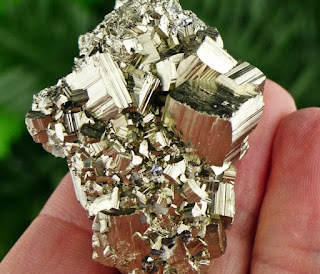The Fascinating Allure of Pyrite: Fool's Gold or Hidden Treasure?
Pyrite, often known as “Fool’s Gold,” has long captivated human curiosity with its metallic luster and golden hue. While it’s easy to understand why many have mistaken it for real gold, this striking mineral has its own unique charm and value—both historically and in the modern world. Let’s dive into the world of pyrite and explore why it’s far more than just a glittering deception.
What Exactly is Pyrite?
Pyrite is an iron sulfide mineral (FeS₂), commonly found in a variety of geological formations, from sedimentary deposits to hydrothermal veins. Its name comes from the Greek word *pyr* meaning “fire,” because it sparks when struck against metal or stone. For centuries, its resemblance to gold has made it both a fascinating curiosity and, occasionally, a source of disappointment for hopeful prospectors.
The "Fool's Gold" Misconception
During the gold rush eras, many hopeful miners mistook pyrite for gold, leading to the nickname “Fool’s Gold.” Though the two look similar, there are easy ways to tell them apart. Pyrite is harder and more brittle, while gold is soft and malleable. If you try to scratch pyrite with a piece of metal, it won’t leave a mark—whereas gold will. Additionally, pyrite forms more angular, cubic crystals, whereas gold tends to have a more malleable, rounded form when found in nuggets.
Despite its deceiving appearance, pyrite wasn’t without value. In the 16th and 17th centuries, it was even mined as a source of sulfur, and today, it’s sometimes used in the production of sulfuric acid.
Pyrite in the Spiritual World
Beyond its physical characteristics, pyrite has found a place in metaphysical practices and crystal healing. Known as a stone of protection and abundance, pyrite is believed to shield against negative energy and promote prosperity. Many people carry pyrite in their pockets or wear it as jewelry to attract wealth and good fortune. It’s also said to boost self-confidence and stimulate creativity, making it a favorite among entrepreneurs and artists.
Scientific and Industrial Uses
While pyrite may not hold the monetary value of gold, it has some practical applications that make it highly useful. Historically, it was a key ingredient in early gunpowder and is still used today in various industrial processes. When heated, pyrite can produce sulfur dioxide, an essential component in the creation of sulfuric acid—a crucial substance for manufacturing fertilizers, chemicals, and even cleaning products.
In recent years, pyrite has even piqued the interest of researchers looking into sustainable energy sources. Some studies suggest that pyrite could be used in low-cost photovoltaic solar cells due to its abundance and semiconductor properties.
Pyrite Jewelry: Beauty in the Bold
Although it lacks the preciousness of gold or diamonds, pyrite is often used in jewelry for its bold, statement-making aesthetic. Its metallic gleam pairs well with both gold and silver, making it versatile in a variety of designs. Cubic pyrite, in particular, with its sharp, geometric shapes, adds a modern and edgy touch to necklaces, bracelets, and rings.
For those who appreciate the beauty of natural minerals, pyrite is a perfect choice. It’s an affordable way to wear a piece of geological history while enjoying its shimmering, eye-catching look.
Collecting and Caring for Pyrite
For mineral collectors, pyrite is a favorite. Its crystalline structure can form in a variety of shapes, from cubes to framboids, and it’s often found alongside other stunning minerals like quartz and calcite. Some of the most impressive pyrite specimens come from Spain, Peru, and the United States.
However, pyrite requires a bit of care. Over time, exposure to moisture can cause it to tarnish or even oxidize, creating a powdery residue known as “pyrite disease.” To keep pyrite specimens looking their best, they should be stored in a dry environment and handled carefully.
The Hidden Value of Pyrite
While it may never hold the same value as gold, pyrite remains a fascinating and versatile mineral with a beauty and history all its own. Its role in science, industry, spirituality, and even fashion makes it a treasure in its own right.
So, next time you come across a gleaming piece of pyrite, don’t dismiss it as “just Fool’s Gold.” Instead, take a moment to appreciate its unique charm and the story it tells—a story that stretches from ancient history to the cutting edge of modern technology. After all, true value isn’t always measured by its price, but by the wonder it inspires.



